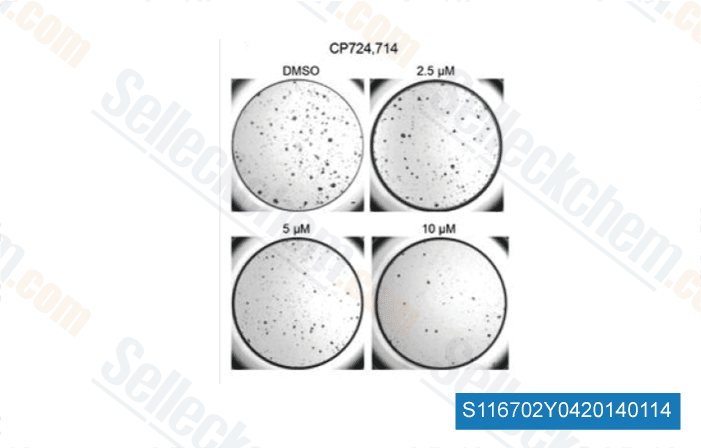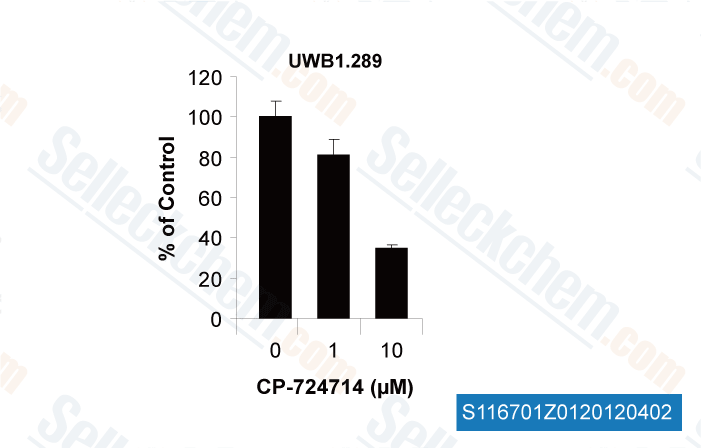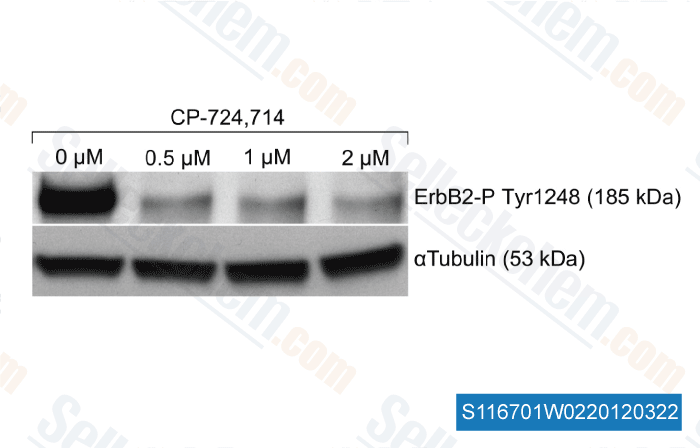|
Toll Free: (877) 796-6397 -- USA and Canada only -- |
Fax: +1-832-582-8590 Orders: +1-832-582-8158 |
Tech Support: +1-832-582-8158 Ext:3 Please provide your Order Number in the email. |
Technical Data
| Formula | C27H27N5O3 |
||||||||||
| Molecular Weight | 469.53 | CAS No. | 537705-08-1 | ||||||||
| Solubility (25°C)* | In vitro | DMSO | 94 mg/mL (200.2 mM) | ||||||||
| Ethanol | 94 mg/mL (200.2 mM) | ||||||||||
| Water | Insoluble | ||||||||||
| In vivo (Add solvents to the product individually and in order) |
|
||||||||||
|
* <1 mg/ml means slightly soluble or insoluble. * Please note that Selleck tests the solubility of all compounds in-house, and the actual solubility may differ slightly from published values. This is normal and is due to slight batch-to-batch variations. * Room temperature shipping (Stability testing shows this product can be shipped without any cooling measures.) |
|||||||||||
Preparing Stock Solutions
Biological Activity
| Description | CP-724714 is a potent, selective inhibitor of HER2/ErbB2 with IC50 of 10 nM, >640-fold selectivity against EGFR, InsR, IRG-1R, PDGFR, VEGFR2, Abl, Src, c-Met etc in cell-free assays. Phase 2. | ||
|---|---|---|---|
| Targets |
|
||
| In vitro | CP-724,714 is marked selectively against EGFR with IC50 of 6.4 μM. CP-724,714 is >1,000-fold less potent for IR, IGF-1R, PDGFRβ, VGFR2, abl. Src, c-Met c-jun NH2-terminal kinase (JNK)-2, JNK-3, ZAP-70, cyclin-dependent kinase (CDK)-2, and CDK-5. CP-724,714 potently reduces the EGF-induced autophosphorylation of the chimera containing the erbB2 kinase domain with IC50 of 32 nM, but is markedly less potent against EGFR in transfected NIH3T3 cells. CP-724,714 sensitively inhibits the proliferation of erbB2-amplified cells including BT-474 and SKBR3, with IC50 of 0.25 and 0.95 μM. CP-724,714 induces the accumulation of cells in G1 phase and a marked reduction in S-phase in BT-474 cells at 1 μM. [1] CP-724,714 likely exerts its hepatotoxicity via both hepatocellular injury and hepatobiliary cholestatic mechanisms. CP-724,714 displays inhibition of cholyl-lysyl and taurocholate (TC) efflux into canaliculi in cryopreserved and fresh cultured human hepatocytes, respectively. CP-724,714 inhibits TC transport in membrane vesicles expressing human bile salt export pump with IC50 of 16 μM and inhibits the major efflux transporter in bile canaliculi, MDR1, with IC50 of ~28 μM. [2] |
||
| In vivo | CP-724,714 (25 mg/kg) is rapidly absorbed after p.o. administration and causes reduction of tumor erbB2 receptor phosphorylation after dosing in FRE-erbB2 or BT-474 xenografts. CP-724,714 induces apoptosis in FRE-erbB2 xenograft–bearing (s.c.) mice and shows 50% tumor growth inhibition at 50 mg/kg, without weight loss or mortality. CP-724,714 also has great antitumor activity in MDA-MB-453, MDA-MB-231, LoVo (colon), and Colo-205 (colon) xenografts. Furthermore, CP-724,714 (30 or 100 mg/kg) reduces the extracellular signal–regulated kinase and Akt phosphorylation in BT-474 xenografts. [1] |
Protocol (from reference)
| Kinase Assay: |
|
|---|---|
| Cell Assay: |
|
| Animal Study: |
|
References
|
Customer Product Validation

-
Data from [ Cancer Res , 2014 , 74(1), 341-52 ]

-
Data from [ Cancer Res , 2013 , 74(1), 341-52 ]

-
, 2012 , Dr. Yong-Weon Yi from Georgetown University Medical Center

-
, 2012 , Reto Baumann from ETH Zurich
Selleck's CP-724714 Has Been Cited by 111 Publications
| ErbB2/HER2 receptor tyrosine kinase regulates human papillomavirus promoter activity [ Front Immunol, 2024, 15:1335302] | PubMed: 38370412 |
| A Non-Canonical p75HER2 Signaling Pathway Underlying Trastuzumab Action and Resistance in Breast Cancer [ Cells, 2024, 13(17)1452] | PubMed: 39273024 |
| A drug discovery pipeline for MAPK/ERK pathway inhibitors in C. elegans [ Cancer Res Commun, 2024, 10.1158/2767-9764.CRC-24-0221] | PubMed: 39212544 |
| The adaptor protein VEPH1 interacts with the kinase domain of ERBB2 and impacts EGF signaling in ovarian cancer cells [ Cell Signal, 2023, 106:110634] | PubMed: 36828346 |
| Sphingosine kinase 1 promotes tumor immune evasion by regulating the MTA3-PD-L1 axis [ Cell Mol Immunol, 2022, 19(10):1153-1167.] | PubMed: 36050478 |
| The adenosine analog prodrug ATV006 is orally bioavailable and has preclinical efficacy against parental SARS-CoV-2 and variants [ Sci Transl Med, 2022, 14(661):eabm7621] | PubMed: 35579533 |
| Blocking glycine utilization inhibits multiple myeloma progression by disrupting glutathione balance [ Nat Commun, 2022, 13(1):4007] | PubMed: 35817773 |
| SHF Acts as a Novel Tumor Suppressor in Glioblastoma Multiforme by Disrupting STAT3 Dimerization [ Adv Sci (Weinh), 2022, e2200169] | PubMed: 35843865 |
| ROS generation attenuates the anti-cancer effect of CPX on cervical cancer cells by inducing autophagy and inhibiting glycophagy [ Redox Biol, 2022, 53:102339] | PubMed: 35636017 |
| CD147 mediates epidermal malignant transformation through the RSK2/AP-1 pathway [ J Exp Clin Cancer Res, 2022, 41(1):246] | PubMed: 35964097 |
RETURN POLICY
Selleck Chemical’s Unconditional Return Policy ensures a smooth online shopping experience for our customers. If you are in any way unsatisfied with your purchase, you may return any item(s) within 7 days of receiving it. In the event of product quality issues, either protocol related or product related problems, you may return any item(s) within 365 days from the original purchase date. Please follow the instructions below when returning products.
SHIPPING AND STORAGE
Selleck products are transported at room temperature. If you receive the product at room temperature, please rest assured, the Selleck Quality Inspection Department has conducted experiments to verify that the normal temperature placement of one month will not affect the biological activity of powder products. After collecting, please store the product according to the requirements described in the datasheet. Most Selleck products are stable under the recommended conditions.
NOT FOR HUMAN, VETERINARY DIAGNOSTIC OR THERAPEUTIC USE.
